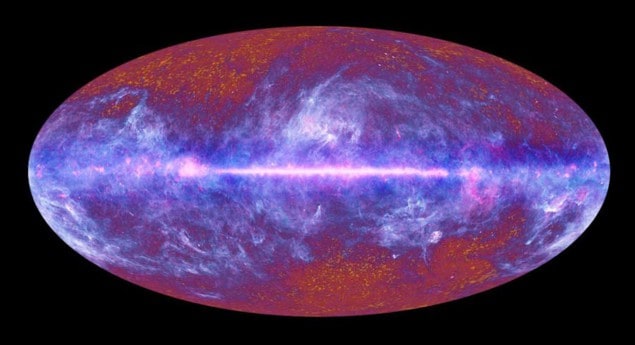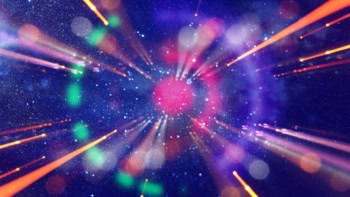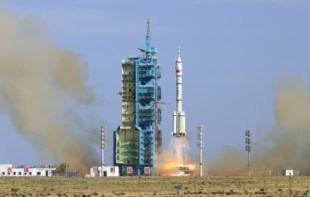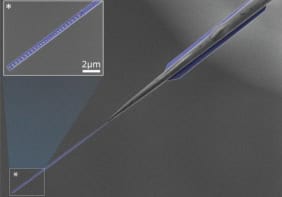
A scientist in the US is arguing that the vacuum should behave as a metamaterial at high magnetic fields. Such magnetic fields were probably present in the early universe, and therefore he suggests that it may be possible to test the prediction by observing the cosmic microwave background (CMB) radiation – a relic of the early universe that can be observed today.
One of 2011’s strangest predictions in physics was the suggestion by Maxim Chernodub of the French National Centre for Scientific Research that, at incredibly high magnetic fields, superconducting states can emerge from the vacuum. This was particularly interesting because one of the main difficulties facing scientists working on traditional superconductivity is preventing superconducting states disappearing in the presence of even moderate magnetic fields.
Soup of quarks and antiquarks
In April Chernodub argued that an extremely high magnetic field should make the vacuum superconducting along the axis of the field – with the vacuum remaining insulating in directions perpendicular to the field. This prediction was based on quantum chromodynamics (QCD), which describes the interactions between quarks and gluons. QCD treats the vacuum not as empty space but as a boiling soup of virtual quarks and antiquarks constantly popping into and out of existence. An up quark can combine with a down antiquark to produce a rho meson.
These rho mesons are normally so unstable that they vanish almost instantaneously; but Chernodub calculated that, at magnetic field strengths greater than 1016 T, the mesons would become massless and therefore stable. This, he predicted, would lead to a superconducting state. However, it would be impossible to test this in the lab today because scientists on Earth have real problems producing fields of more than 100 T.
Now Igor Smolyaninov of the University of Maryland has built on Chernodub’s work to show that parallel magnetic field lines in a vacuum would arrange themselves to form a triangular lattice in the plane perpendicular to the field – much like an Abrikosov lattice in a superconductor. The vacuum near to each field line would be a superconductor, while the regions between the field lines would be an insulator.
Bizarre properties
This configuration is very similar to that of certain man-made metamaterials that are made from lattices containing regions of conducting and insulating materials. Smolyaninov has shown that this magnetic-field-induced lattice would function as a hyperbolic metamaterial. Such metamaterials possess the bizarre, counterintuitive optical property of having a negative refractive index and have been used to create superlenses capable of resolving features smaller than the diffraction limit imposed on normal lenses.
While physicists do not have access to magnetic fields strong enough to test Smolyaninov’s theory, the magnetic field in the universe in the first fraction of a second after the Big Bang may have been strong enough to give rise to Chernodub’s superconducting state. The universe as a whole may, therefore, have behaved as a giant metamaterial superlens, argues Smolyaninov. Although he has yet to make a definite, testable prediction, Smolyaninov suggests that it should be possible to test the metamaterial idea – and, by inference, the whole idea of vacuum superconductivity – by looking for imprints of this lensing effect on the present-day structure of the universe, and in particular on the CMB.
“Right in front of my nose”
Chernodub is impressed and explains that while continuing to work on vacuum superconductivity, he had also been thinking about metamaterials in high-energy physics without ever connecting the two concepts. “Then Smolyaninov comes along and says ‘Hey, you know your superconductor is a perfect metamaterial’,” he laughs. “It was as if I was looking for a coin and he pointed it out right in front of my nose.” He questions, however, whether or not the extremely hot, dense conditions in the very early universe may have been so far from the zero temperature and pressure model used in Smolyaninov’s paper – and his own – that superconductivity, and therefore metamaterial lensing, would have been impossible.
Cosmologist Andrew Jaffe from Imperial College London is also sceptical about the potential to test the idea using evidence from the early universe. “I think there is one major sticking point, which is that many of the ideas for generating very strong magnetic fields would happen when the universe was small compared with the radius of the rho meson. Hence, I’m not sure that Smolyaninov’s calculations would apply. By the time they did apply, I suspect the magnitude of the field would have been too small to have the vacuum-polarization effect.”
The research is described in Physical Review Letters.



